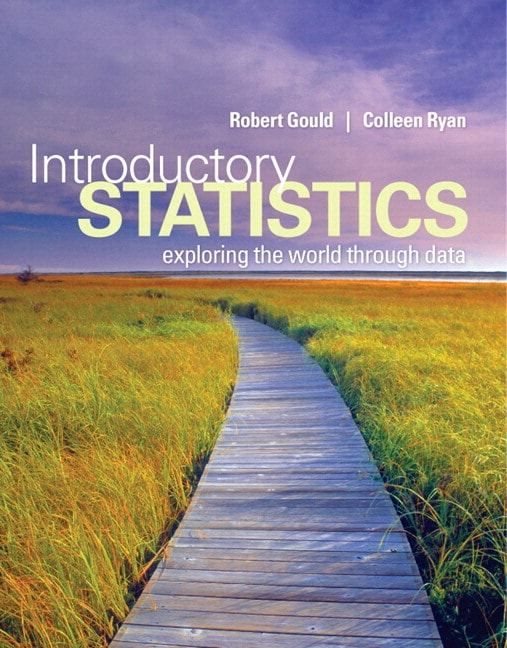Buy Introductory Statistics: Exploring the World through Data Plus NEW MyLab Statistics with Pearson eText Package TESTBANK with Paypal

35.00$
Table of Contents
1. Introduction to Data
Case Study: Deadly Cell Phones?
1.1 What Are Data?
1.2 Classifying and Storing Data
1.3 Organizing Categorical Data
1.4 Collecting Data to Understand Causality
Exploring Statistics: Collecting a Table of Different Kinds of Data
2. Picturing Variation with Graphs
Case Study: Student-to-Teacher Ratio at Private and Public Colleges
2.1 Visualizing Variation in Numerical Data
2.2 Summarizing Important Features of a Numerical Distribution
2.3 Visualizing Variation in Categorical Variables
2.4 Summarizing Categorical Distributions
2.5 Interpreting Graphs
Exploring Statistics: Personal Distance
3. Numerical Summaries of Center and Variation
Case Study: Living in a Risky World
3.1 Summaries for Symmetric Distributions
3.2 What's Unusual? The Empirical Rule and z-Scores
3.3 Summaries for Skewed Distributions
3.4 Comparing Measures of Center
3.5 Using Boxplots for Displaying Summaries
Exploring Statistics: Does Reaction Distance Depend on Gender?
4. Regression Analysis: Exploring Associations between Variables
Case Study: Catching Meter Thieves
4.1 Visualizing Variability with a Scatterplot
4.2 Measuring Strength of Association with Correlation
4.3 Modeling Linear Trends
4.4 Evaluating the Linear Model
Exploring Statistics: Guessing the Age of Famous People
5. Modeling Variation with Probability
Case Study: SIDS or Murder?
5.1 What is Randomness?
5.2 Finding Theoretical Probabilities
5.3 Associations in Categorical Variables
5.4 Finding Empirical Probabilities with Simulations
Exploring Statistics: "Let's Make a Deal": Stay or Switch?
6. Modeling Random Events: The Normal and Binomial Models
Case Study: You Sometimes Get More Than You Pay For
6.1 Probability Distributions Are Models of Random Experiments
6.2 The Normal Model
6.3 The Binomial Model
Exploring Statistics: ESP with Coin Flipping
7. Survey Sampling and Inference
Case Study: Spring Break Fever: Just What the Doctors Ordered?
7.1 Learning about the World through Surveys
7.2 Measuring the Quality of a Survey
7.3 The Central Limit Theorem for Sample Proportions
7.4 Estimating the Population Proportion with Confidence Intervals
7.5 Margin of Error and Sample Size for Proportions (Optional)
Exploring Statistics: Simple Random Sampling Prevents Bias
8. Hypothesis Testing for Population Proportions
Case Study: Does Watching Violent TV as a Child Lead to Violent Behavior as an Adult?
8.1 The Main Ingredients of Hypothesis Testing
8.2 Characterizing p-values
8.3 Hypothesis Testing in Four Steps
8.4 Comparing Proportions from Two Populations
8.5 Understanding Hypothesis Testing
Exploring Statistics: Identifying Flavors of Gum through Smell
9. Inferring Population Means
Case Study: Epilepsy Drugs and Children
9.1 Sample Means of Random Samples
9.2 The Central Limit Theorem for Sample Means
9.3 Answering Questions about the Mean of a Population
9.4 Comparing Two Population Means
9.5 Overview of Analyzing Means
Exploring Statistics: Pulse Rates
10. Associations between Categorical Variables
Case Study: Popping Better Popcorn
10.1 The Basic Ingredients for Testing with Categorical Variables
10.2 The Chi-Square Test for Goodness of Fit
10.3 Chi-Square Tests for Associations between Categorical Variables
10.4 Hypothesis Tests When Sample Sizes Are Small
Exploring Statistics: Skittles
11. Multiple Comparisons and Analysis of Variance
Case Study: Seeing Red
11.1 Multiple Comparisons
11.2 The Analysis of Variance
11.3 The ANOVA Test
11.4 Post-Hoc Procedures
Exploring Statistics: Recovery Heart Rate
12. Experimental Design: Controlling Variation
Case Study: Does Stretching Improve Athletic Performance?
12.1 Variation Out of Control
12.2 Controlling Variation in Surveys
12.3 Reading Research Papers
Exploring Statistics: Reporting on Research Activities
13. Inference without Normality
Case Study: Electric Rays
13.1 Transforming Data
13.2 The Sign Test for Paired Data
13.3 Mann-Whitney Test for Two Independent Groups
13.4 Randomization Tests
Exploring Statistics: Balancing on One Foot
14. Inference for Regression
Case Study: Building a Better Oyster Shucker
14.1 The Linear Regression Model
14.2 Using the Linear Model
14.3 Predicting Values and Estimating Means
Exploring Statistics: Older and Slower?
Category : Higher Education
Instalant Download Introductory Statistics: Exploring the World through Data Plus NEW MyLab Statistics with Pearson eText Package by Robert Gould, University of California, Los Angeles Colleen N. Ryan, California Lutheran University with Paypal
Introductory Statistics: Exploring the World through Data Plus NEW MyLab Statistics with Pearson eText Package , buy Introductory Statistics: Exploring the World through Data Plus NEW MyLab Statistics with Pearson eText Package with paypal , Robert Gould, University of California, Los Angeles Colleen N. Ryan, California Lutheran University
How can I download Introductory Statistics: Exploring the World through Data Plus NEW MyLab Statistics with Pearson eText Package?
You will receive an email from testbank that contains the download link or the test bank will be attached to email
I am not able to download my test bank or solution manual ?
If you could not download your product for any reason, contact us and we will solve the issue immediately.

Comments
Post a Comment